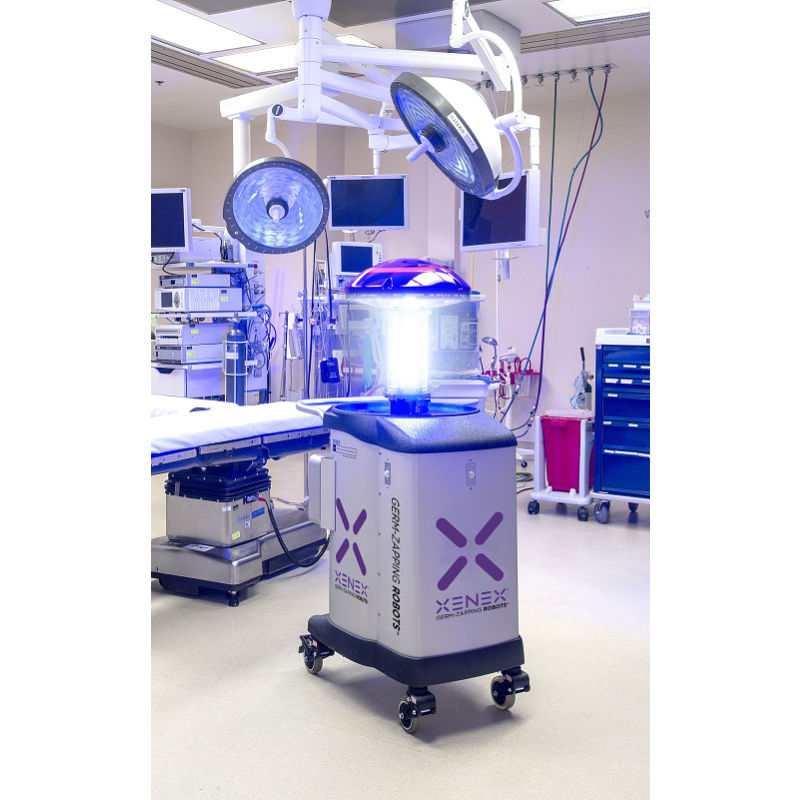
Surgical site infections decreased 100 percent at Trinity Medical Center after the facility implemented an infection control bundle that included Xenex germ-zapping robots for room disinfection. This is the sixth peer-reviewed study published by a facility that experienced a decrease in hospital acquired infections after it began using Xenex pulsed xenon UV light technology to destroy microorganisms like C.diff and MRSA. (Credit: PRNewsFoto/Xenex Disinfection Services)
Surgical Site Infections (SSIs) are devastating for patients and pose a significant financial risk for hospitals. Surgical Site Infections resulting from total knee or hip procedures cause excruciating pain and suffering, have a three percent mortality rate and are associated with an additional $21,000 in additional care costs per infection. As hospitals worldwide struggle to prevent infections, Alabama-based Trinity Medical Center experienced a 100 percent decrease in Surgical Site Infection rates in its orthopedic Operating Rooms (ORs) after implementing a total joint infection control bundle that includes Xenex Germ-Zapping Robots to disinfect its ORs and patient rooms.
Surgical site infections decreased 100 percent at Trinity Medical Center after the facility implemented an infection control bundle that included Xenex germ-zapping robots for room disinfection. This is the sixth peer-reviewed study published by a facility that experienced a decrease in hospital acquired infections after it began using Xenex pulsed xenon UV light technology to destroy microorganisms like C.diff and MRSA.
In the peer-reviewed study “Influence of a total joint infection control bundle on surgical site infection rates” in the American Journal of Infection Control (AJIC), the authors describe the measures they took to achieve a 100 percent reduction in Surgical Site Infection rates. The AJIC study states that the intervention may have prevented seven infections, averted one death, and saved $290,990 over the 12 months studied. This is the sixth peer-reviewed study published by a hospital that experienced a decrease in Hospital Acquired Infection (HAI) rates after it began using the Xenex pulsed xenon Full Spectrum ultraviolet (UV) room disinfection system to destroy the microorganisms that cause HAIs.
According to the study, in 2012, Trinity’s Surgical Site Infection rates were excellent; below the national average, but hospital leadership evaluated and introduced an infection control bundle in 2013 with the goal of further reducing its Surgical Site Infection rates. The bundled program that reduced total joint Surgical Site Infections at Trinity Medical Center was quality improvements and no-touch environmental disinfection with pulsed xenon UV light disinfection technology from Xenex Disinfection Services.
Trinity’s Surgical Site Infection reduction results were dramatic. According to the study, in 2012, four Surgical Site Infections were reported from 200 total-hip procedures and three Surgical Site Infections were reported from 191 total-knee procedures. After implementation of the infection control bundle, no Surgical Site Infections were reported from 191 total-hip procedures or 394 total-knee procedures in 2013. During this time, antibiotic treatment and wound dressing techniques remained constant.
Multiple studies have shown that significant environmental contamination exists in hospital rooms, even after manual cleaning has taken place. Germs and bacteria like Clostridium difficile (C.diff) and methicillin resistant Staphylococcus aureus (MRSA) can live on surfaces for months. To reduce the bacterial load in its orthopedic wing, Trinity began disinfecting its operating rooms (ORs) nightly using pulsed xenon UV disinfection. The Xenex device was operated for 5-10 minutes in multiple positions in each OR. Upon patient discharge, patient rooms were cleaned and then disinfected using the Xenex device. Compliance with the Xenex disinfection protocol was monitored using the robot’s onboard data log, which communicates with a cloud-based portal where usage data is stored. The use of pulsed xenon UV disinfection was combined with quality improvement initiatives described in the paper.
Trinity Medical Center moved in October 2015 to a new facility in Birmingham, Grandview Medical Center, where they continue to use Xenex for room disinfection.
“This 100 percent reduction in infections is good news for patients in Birmingham. No one should go to the hospital for a procedure or treatment and unknowingly contract a painful and potentially lethal infection. Surgeons should want to operate at Grandview Medical Center because they are doing more to keep their patients safe by eliminating the pathogens that could endanger them,” said Morris Miller, CEO of Xenex. “Trinity becomes the sixth hospital to publish a peer-reviewed outcome study showing a decrease in infection rates after using the Xenex Germ-Zapping Robot for room disinfection. I hope that other hospitals are watching closely because Xenex offers the only UV disinfection technology shown, in multiple peer reviewed published outcome studies, to effectively reduce HAI rates.”
Only UV Disinfection System Proven to Reduce HAI Rates
MD Anderson Cancer Center, the Central Texas Veterans Health Care System, Cooley Dickinson Health Care and other hospitals have published 13 studies providing evidence of the Xenex robot’s efficacy in highly regarded scientific journals that include AJIC, Journal of Infection Prevention, Infection Control & Hospital Epidemiology (ICHE) and BMC Infectious Diseases. Hospitals that purchased Xenex robots have reported greater than 50 percent decreases in MRSA and C.diff infection rates in peer-reviewed literature, documenting how they used the Xenex robot in their hospital to reduce infection rates.
Designed for speed, effectiveness and ease of use, hospital cleaning staff operate the robot without disrupting hospital operations. The robot pulses intense UV light covering the entire UV spectrum, destroying viruses, bacteria and bacterial spores in a five-minute disinfection cycle. Without contact or chemicals, the robot destroys harmful microorganisms safely and effectively. The robot can disinfect 30-62 hospital rooms per day (according to Xenex customers), including: patient rooms, operating rooms, equipment rooms, emergency rooms, intensive care units and public areas. More than 300 hospitals, Veterans Affairs, Department of Defense, skilled nursing facilities, ambulatory surgery centers and long-term acute care facilities in the U.S., Europe, Canada and Africa use Xenex robots.




